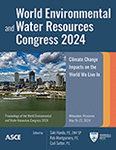A Case Study of How the Hydrologic Engineering Center (HEC) Suite of Tools Can Be Deployed to Perform Automated Forecasting
Publication: World Environmental and Water Resources Congress 2024
ABSTRACT
The US Army Corps of Engineers’ (USACE) Hydrologic Engineering Center (HEC) suite of software is a well-established set of hydrologic and hydraulic (H&H) modeling tools that is capable of ingesting meteorological data to provide estimates of streamflow, flood inundation, and other H&H data. Traditional utilization of the HEC software suite revolves around its utility as a desktop application. However, HEC now enables API access to its models for scripting. HEC also releases Linux distributions of its modeling platforms and open-source software packages. Additionally, HEC is now developing cloud-based software to automate execution of the HEC models. Here, we present a case study implementation of HEC software in the Lower Rio Grande Valley (LRGV) to perform automated flood forecasting. We describe the process undertaken to enable this automated forecasting, including the development and deployment of the HEC models. Further, we provide a description of how we assimilate hydrologic observations into the HEC models and an account of the software needed to perform the modeling. Our results describe an instance of how the desktop modeling undertaken in the HEC modeling suite automates flood forecasting in the cloud.
Get full access to this chapter
View all available purchase options and get full access to this chapter.
REFERENCES
Adams, T. E., Chen, S., and Dymond, R. (2018). Results from Operational Hydrologic Forecasts Using the NOAA/NWS OHRFC Ohio River Community HEC-RAS Model. Journal of Hydrologic Engineering, 23(7). https://doi.org/10.1061/(asce)he.1943-5584.0001663.
Anaconda Inc. (2017). Miniconda. https://docs.conda.io/projects/miniconda/en/latest/.
Bazan, B. E., Hagemann, M., and Kim, K. (2016). Delineating Stream Flowlines and Watershed Boundaries in the Lower Rio Grande Valley Using High Resolution LiDAR Derived Digital Elevation Models. In (pp. 13–18). https://doi.org/10.4211/technical.20161019.
Dowell, D. C., et al. (2022). The High-Resolution Rapid Refresh (HRRR): An Hourly Updating Convection-Allowing Forecast Model. Part I: Motivation and System Description. Weather and Forecasting, 37(8), 1371–1395. https://doi.org/10.1175/WAF-D-21-0151.1.
Ghimire, E., and Sharma, S. (2021). Flood Damage Assessment in HAZUS Using Various Resolution of Data and One-Dimensional and Two-Dimensional HEC-RAS Depth Grids. Natural Hazards Review, 22(1). https://doi.org/10.1061/(asce)nh.1527-6996.0000430.
Guerra Uribe, M. E. (2017). Flood Risk Areas in The Rio Grande Valley Colonias. https://www.caee.utexas.edu/prof/maidment/giswr2017/TermProject/FinalReports/MonicaGuerraUribe.pdf.
Islam, M. S., Bonner, J. S., Paley, J. B., and Fuller, C. B. (2016). Low-Cost Stand-Alone System for Real-Time Hydrological Monitoring. Environmental Engineering Science, 33(12), 929–941. https://doi.org/10.1089/ees.2016.0106.
Jafarzadegan, K., and Moradkhani, H. (2020). Regionalization of stage-discharge rating curves for hydrodynamic modeling in ungauged basins. Journal of Hydrology, 589. https://doi.org/10.1016/j.jhydrol.2020.125165.
Jython. (n.d.). What is Jython? Retrieved July 23, 2023, from https://www.jython.org/.
Kannan, N., Jeong, J., and Srinivasan, R. (2011). Hydrologic Modeling of a Canal-Irrigated Agricultural Watershed with Irrigation Best Management Practices: Case Study. Journal of Hydrologic Engineering, 16(9), 746–757. https://doi.org/10.1061/(asce)he.1943-5584.0000364.
Lin, Q., Lin, B., Zhang, D., and Wu, J. (2022). Web-based prototype system for flood simulation and forecasting based on the HEC-HMS model. Environmental Modelling and Software, 158. https://doi.org/10.1016/j.envsoft.2022.105541.
NOAA (National Oceanic and Atmospheric Administration). (2023a, March 28). The High-Resolution Rapid Refresh (HRRR). https://rapidrefresh.noaa.gov/hrrr/.
NOAA (National Oceanic and Atmospheric Administration). (2023b, June). NOAA Operational Model Archive and Distribution System. https://nomads.ncep.noaa.gov/.
Navarro, L., Mahmoud, A., Ernest, A., Oubeidillah, A., Johnstone, J., Chavez, I. R. S., and Fuller, C. (2021). Development of a cyberinfrastructure for assessment of the lower rio grande valley north and central watersheds characteristics. Sustainability (Switzerland), 13(20). https://doi.org/10.3390/su132011186.
Pak, J. H., Fleming, M., Scharffenberg, W., Gibson, S., and Brauer, T. (2015). Modeling Surface Soil Erosion and Sediment Transport Processes in the Upper North Bosque River Watershed, Texas. Journal of Hydrologic Engineering, 20(12). https://doi.org/10.1061/(ASCE)HE.1943-5584.0001205.
Pak, J., Pradhan, N., Floyd, I., and Fleming, M. (2023, May 11). Post-Wildfire Hydrology and Debris Flow Analysis Using Hydrologic Modeling System (HEC-HMS). SEDHYD 2023 Conference. https://www.hec.usace.army.mil/confluence/hmsdocs/hmsguides/applying-debris-.
QGIS Foundation Inc. (2021). QGIS Version 3.18.2. https://download.qgis.org/downloads/qgis-3.18.2.tar.bz2.
RATES Inc. (2023). rtsPy. https://github.com/jlgutenson/rtsPy.
Ross, A. D., Nejat, A., and Greb, V. (2023). Institutional foundations of adaptive planning: exploration of flood planning in the Lower Rio Grande Valley, Texas, USA. Sustainable and Resilient Infrastructure, 8(4), 419–436. https://doi.org/10.1080/23789689.2023.2180249.
Saldaña, L. (2023). Remnants of the Rio Grande: Resacas. Texas Highways. https://texashighways.com/things-to-do/on-the-water/resacas-are-the-natural-wonders-of-texas-rio-grande-valley/.
Teal, M. J., and Allan, R. (2017). Creating a Flood Warning System for the San Diego River Using HEC-RTS Software. World Environmental and Water Resources Congress 2017. https://doi.org/10.1061/9780784480601.023.
Teng, F., Huang, W., and Ginis, I. (2018). Hydrological modeling of storm runoff and snowmelt in taunton river basin by applications of HEC-HMS and PRMS models. Natural Hazards, 91(1), 179–199. https://doi.org/10.1007/s11069-017-3121-y.
TWDB (Texas Water Development Board). (2023). TNRIS DataHub. https://data.tnris.org/.
USACE. (2021, December 8). Batch Import Options. Github. https://github.com/HydrologicEngineeringCenter/Vortex/wiki/Batch-Import-Options.
USACE. (2022). data-retrieval-scripts. https://github.com/HydrologicEngineeringCenter/data-retrieval-scripts.
USACE. (2023a). About HEC. https://www.hec.usace.army.mil/about/history.aspx.
USACE. (2023b). Blending Computed Flow with Observed Flow. https://www.hec.usace.army.mil/confluence/hmsdocs/hmsum/4.11/forecasting-streamflow/blending-computed-flow-with-observed-flow.
USACE. (2023c). cloudcompute. Github. https://github.com/USACE/cloudcompute.
USACE. (2023d). Forecast Alternatives. https://www.hec.usace.army.mil/confluence/hmsdocs/hmsum/4.11/forecasting-streamflow/forecast-alternatives.
USACE. (2023e). HEC-DSSVue. https://www.hec.usace.army.mil/software/hec-dssvue/.
USACE. (2023f). HEC-HMS. https://www.hec.usace.army.mil/software/hec-hms/.
USACE. (2023g). HEC-RAS. https://www.hec.usace.army.mil/software/hec-ras/.
USACE. (2023h). Reach Outflow Initialization. https://www.hec.usace.army.mil/confluence/hmsdocs/hmsum/4.11/forecasting-streamflow/reach-outflow-initialization.
USACE. (2023j). Subbasin Baseflow Initialization. https://www.hec.usace.army.mil/confluence/hmsdocs/hmsum/4.11/forecasting-streamflow/subbasin-baseflow-initialization.
USACE. (2023k). Vortex. https://github.com/HydrologicEngineeringCenter/Vortex.
USACE. (2023m, June 8). Vortex: v0.11.0. https://github.com/HydrologicEngineeringCenter/Vortex/releases/tag/v0.11.0.
FEMA. (2022). Software for Flood Mapping. https://www.fema.gov/flood-maps/software.
USGS. (2011). USGS Stage-Discharge Relation Example. https://www.usgs.gov/media/images/usgs-stage-discharge-relation-example.
USGS. (2019, March 3). Streamgaging Basics. https://www.usgs.gov/mission-areas/water-resources/science/streamgaging-basics.
Information & Authors
Information
Published In
History
Published online: May 16, 2024
ASCE Technical Topics:
- Automation and robotics
- Case studies
- Computer programming
- Computer software
- Computing in civil engineering
- Disaster risk management
- Disasters and hazards
- Engineering fundamentals
- Floods
- Forecasting
- Hydrologic engineering
- Hydrologic models
- Mathematics
- Methodology (by type)
- Models (by type)
- Natural disasters
- Research methods (by type)
- Statistics
- Systems engineering
- Water and water resources
Authors
Metrics & Citations
Metrics
Citations
Download citation
If you have the appropriate software installed, you can download article citation data to the citation manager of your choice. Simply select your manager software from the list below and click Download.
